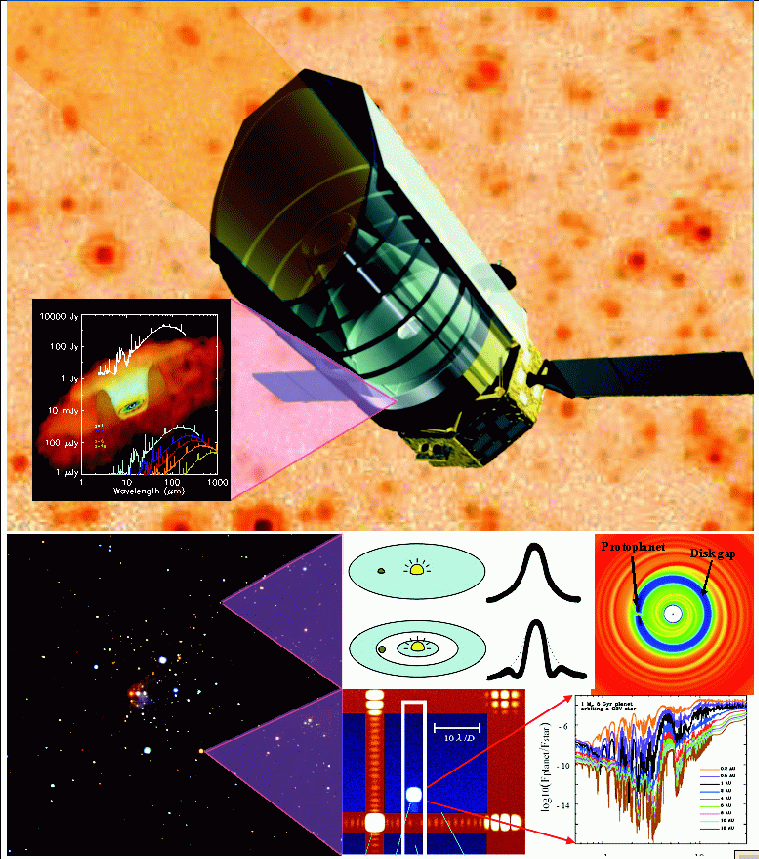SPICA
SPace Infrared
Telescope for Cosmology and
Astrophysics

The next generation infrared space observatory SPICA, co-proposed by a team of
scientists from institutes in Europe and Japan including UCLan's
Centre for Astrophysics, has been accepted by the European Space Agency (ESA)
for inclusion within the agency's "Cosmic Visions" program of prospective
space science missions to be flown in the 2015-2025 period. SPICA is a
far-infrared space observatory with a large-aperture (3.5 m) cryogenic
telescope (actively cooled to 4.5 K). The mission will
address planetary formation, the way
the solar system works and the origin of the universe. It will perform wide
field, high sensitivity photometric mapping at high spatial resolution,
spectral analysis as well as coronography of planets and planetary disks.
SPICA is proposed in collaboration with the Japanese Aerospace Exploration
Agency, JAXA, with ESA providing the telescope and a contribution to the
operations.
UCLan will help develop one of SPICA's three focal plane instruments,
the so-called "European Spica Instrument" (ESI). We will perform
simulations of the expected
infrared signature of galaxies throughout cosmic time to constrain both
the science program and the instrument design.
The composite picture on the right:
The foreground image shows an artists impression of the SPICA spacecraft
with the thermal shield cut away to show the telescope assembly (ISAS/JAXA).
The background image is one of the Spitzer GOODS-S MIPS 24 micron deep
extragalactic survey fields, which is available from the NASA Spitzer Science
Centre:
http://data.spitzer.caltech.edu/popular/goods/Documents/goods_dr3.html.
To the left of the spacecraft the redshift spectrum of a typical
starburst galaxy M82 (RAL) is shown, superimposed on an artists impression of
a dusty
torus surrounding an active galactic nucleus (NASA/CXO).
Bottom left shows an obscured galactic star cluster taken in the
near-infrared (H, J, K composite image) using the LIRIS instrument on the
William Herschel Telescope (Image kindly provided by the joint CSIC and IAC
MASGOMAS project).
To the right it is shown how SPICA will use high resolution MIR spectroscopy to
determine the structure of gaseous disks - upper (NAOJ) - and a coronagraph to
image and take spectra of young planets - bottom (ISAS/JAXA).
Participating institutes:
Cardiff University, UK
CEA-CENG Service des Basses Temperatures, Grenoble, France
CEA-DAPNIA, Service d'Astrophysique, Saclay, France
Centre d'Etude Spatiale des Rayonnements, OMP-UPS, Toulouse, France
Departamento de Astrofisica Molecular e Infrarroja, IEM, CSIC, Madrid,
Spain
GEPI, Observatoire de Paris, France
Gunma Astronomical Observatory, Japan
Hiroshima University, Japan
Ibaraki University, Japan
IMEC, Belgium
Imperial College, London, UK
Institut d'Astrophysique de Paris, France
Institut d'Astrophysique Spatiale, Orsay, France
Instituto de Astrofisica de Canarias, Spain
Instituut voor Sterrenkunde K.U. Leuven, Belgium
Istituto di Fisica dello spazio Interplanetario, Italy
Istituto Nazionale di Fisica Nucleare, Roma, Italy
Japan Aerospace Exploration Agency, Japan
Jet Propulsion Laboratory, Pasadena, USA
Korea Astronomy and Space Science Institute (KASI), Korea
Kobe University, Japan
Kyoto University, Japan
Kyung Hee University, Korea
Laboratoire d'Astrophysique de Marseille, OAMP, France
Laboratoire d'Astrophysique de Bordeaux, OASU, France
LERMA, Observatoire de Paris, France
Leiden Observatory, University of Leiden, The Netherlands
Max-Planck Institut für extraterrestrische Physik, Germany
Max-Planck Institut für Astronomie, Germany
Max-Planck Institut für Kernphysik, Germany
Nagoya University, Japan
Nagoya City University, Japan
Netherlands Institute for Space Research (SRON), The Netherlands
Netherlands Institute for Space Research (SRON), The Netherlands
National Astronomical Observatory of Japan (NAOJ), Japan
Niigata University, Japan
Rikkyo University, Japan
Rutherford Appleton Laboratory, UK
Seoul National University (SNU), Korea
Strathclyde University, UK
Sussex University, UK
The Open University, UK
Tokyo Institute of Technology, Japan
UK Astronomy Technology Centre, Edinburgh, UK
University of Central Lancashire, Preston, UK
University College London, UK
Universita di Roma, Italy
University of Lethbridge, Canada
University of Tokio, Japan
[an error occurred while processing this directive]
Return to: Main page
